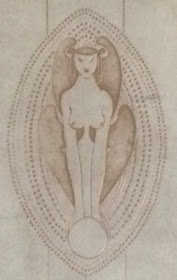I used to revere him and think I knew what he was: but it was not until after Shannon’s calamity that I realised all his grandeur as well as greatness. Every time I was with him after that he opened out more and more: and I used to come away with a new awe mingling with my ancient admiration. There was one night when he kept Emily and me sitting late, and then walked with us to the ’bus, that we never forget: his loneliness, his solicitude for Shannon, the dignity and beauty of all he said made us often feel like tears if he had not been on a plane beyond them.
[Unpublished letter from Gordon Bottomley to Thomas Sturge Moore, 1 November 1931]
During his last year Ricketts had made a summer trip to Italy, but he was bored and felt depressed and tired. Shannon, who, after his fall, had never become himself again, 'developed a "phobia" against his studio and against Ricketts' (as Paul Delaney informs us in his biography of Ricketts). Ricketts threw himself into his work and designed dresses and scenery for Ferdinand Bruckner's play Elizabeth of England, but he couldn't handle it all, and asked Henning Nyberg to complete his work, while Bruce Winston saw after the costumes.
His doctor treated him for indigestion, and it was said to be nothing serious. In the early morning of 7 October 1931, his man-servant Percy Nicholls brought Ricketts his medicine. When Nicholls returned a few hours later, Ricketts had died in his sleep of heart failure. Delaney adds: 'Indeed, one might say he had died of a broken heart.'
What then follows are stories about the cremation, the memorial service and the scattering of the ashes. But in the meantime some events had occurred and they were due to the doctor's misdiagnosis.
Here is what Thomas Sturge Moore wrote to Gordon Bottomley on 21 December 1931:
The doctor diagnosed Ricketts['] case quite wrong and gave him exactly the worst treatment, and then refused to sign the death certificate so that the police took his poor body away for a couple of days for Dr Spillsbury to examine. As Jackson says if any man ever died of a broken heart it was Ricketts. [...] But I expect Nyberg has written all the details to you. And I suppose they ought to be forgotten.
[Unpublished letter from Gordon Bottomley to Thomas Sturge Moore, 1 November 1931]
 |
| The gravestone of Gordon and Emily Bottomley, at Dundurn, Perthshire [Photo: Thinair: Wikimedia Commons] |
His doctor treated him for indigestion, and it was said to be nothing serious. In the early morning of 7 October 1931, his man-servant Percy Nicholls brought Ricketts his medicine. When Nicholls returned a few hours later, Ricketts had died in his sleep of heart failure. Delaney adds: 'Indeed, one might say he had died of a broken heart.'
What then follows are stories about the cremation, the memorial service and the scattering of the ashes. But in the meantime some events had occurred and they were due to the doctor's misdiagnosis.
Here is what Thomas Sturge Moore wrote to Gordon Bottomley on 21 December 1931:
The doctor diagnosed Ricketts['] case quite wrong and gave him exactly the worst treatment, and then refused to sign the death certificate so that the police took his poor body away for a couple of days for Dr Spillsbury to examine. As Jackson says if any man ever died of a broken heart it was Ricketts. [...] But I expect Nyberg has written all the details to you. And I suppose they ought to be forgotten.
[Unpublished letter from T. Sturge Moore to Gordon Bottomley, 21 December 1931]
Indeed, Nyberg had written Bottomley, but he hadn't touched on these sinister details.
 |
| Bernard Spilsbury, c. 1925 [Photo: Official Home Office photograph] [Wikimedia Commons] |
Bernard Spilsbury (1877-1947) - Moore added a letter 'l' to the name - was a famous pathologist who performed thousands of autopsies following sudden deaths, including murder victims, but he also examined the bodies of executed criminals. Ricketts's sudden death needed to be examined.
These fragments are published as a prepublication of the forthcoming online edition of the complete correspondence of Thomas Sturge Moore and Gordon Bottomley, which is being prepared by John Aplin for InteLex Past Masters.
I am very grateful to John Aplin for agreeing to this pre-publication.












